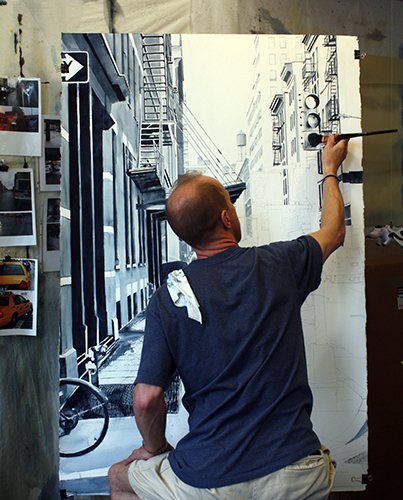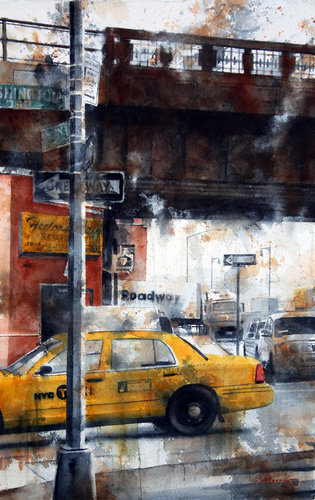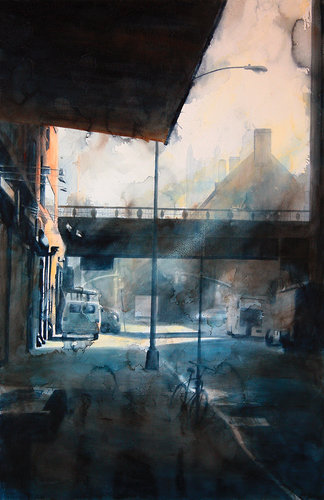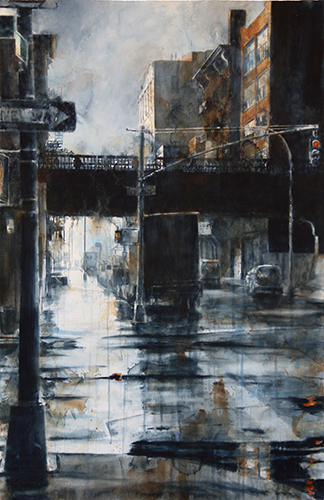by guest blogger Tim Saternow
When an artist creates a series of works, it’s an opportunity to make a powerful statement.

Artist Tim Saternow paints in his studio.
When I first started to seriously paint, finding subject matter I liked was always difficult. The problem was finding something I wanted to paint. I always noticed and loved the way the sun gleams across the old buildings of New York City. I particularly liked the way sunlight played off the rusted and dirty surface of this old freight train trestle outside my building. This was the High Line way before it was a park. This first painting lead to many others and my High Line series was first born out of necessity. Then it became my passion.
A series of paintings or sculpture has an immediate attraction. A good series commands and maintains the interest of the viewer, not only in galleries but in online exhibits as well. Galleries seem to now require a series of work to exhibit, and this is now the standard for solo shows. That requirement is practical as well: a series makes for a coherent and deeper display of an artist’s current ideas. It not only shows the depth and breadth of an artist’s skill, it more importantly tells a story. It leads the viewer deeper into the artist’s own personal journey.
It’s an enjoyable experience to see where an artist can takes us. We observe how the artist can see so many different sides of the same subject. Each piece should be strong enough alone, but taken together is the greater experience.

“Hector’s Diner Under the High Line” watercolor, 21″ x 15″ by Tim Saternow.
So, what is a series?
A series is any collection of work that has a coherent and recognizable line. This can be as simple as color and materials, or as complex as subjects like gender roles or political agendas. Generally, a series requires either visual unity (color, materials, size, shape, composition) or intellectual unity (themes, concepts, and ideas that may have little visually similar). Usually the most successful series are a combination of both the visual and the intellectual.
While a strong artists’ individual technique will always set them apart, taking that technique and applying to a theme can render powerful results. The one requirement for a successful series is passion.

“West 21st Street, Morning” watercolor, 40″ x 26″ by Tim Saternow
An artist’s excitement and curiosity about a particular theme or idea can inform the viewer to distinct new insights. The Impressionists focused on how natural light changes throughout the day, exemplified by Monet’s exploration of the Rouen Cathedral exploring the changing light on the cathedral’s façade. Or, at the very beginning of his Pop career, it was Andy Warhol’s fascination with the media spectacle around Jackie Kennedy after the assassination. Or Jackson’s Pollack’s evolving the technique of pouring and splashing, and how the material of liquid paint can be exploited and utilized into something totally new. Passion all around.
It’s all visual storytelling. A series expresses a much more wide-ranging voice than a single piece. It allows the viewer to become fully engaged in these ideas as it creates a deeper experience into the artwork. A series requires more than just a cursory scratch on the surface of an idea. It should take us on a journey into the artists’ deeper and more meaningful personal expression.

“West 29th Street, Postal Truck, Rain” watercolor, 40″ x 26″ by Tim Saternow
Practically, why paint in a series?
First, you will make more art to sell. Reviewers and critics can craft much better stories about the themes and their significance. Storytelling produces a more positive viewer response. And it’s also a great base for a collector to assemble their collection.
My fascination with the High Line became my first New York solo exhibition at the George Billis Gallery. This show of 18 paintings looked at the old abandoned industrial character of that exact neighborhood, soon to be cleaned up, built up, and painted over. The worry about the High Line’s future existence was shared by many in that community, since the High Line Park literally cuts right through the Chelsea Art Gallery District of New York.
My curiosity seemed prescient, but I didn’t know then what a smash hit that park was soon to become. Although there is a bit of nostalgia for the neighborhood’s past history, my High Line series is now a record of what was once was a major part of industrial New York. And interest in the High Line has not diminished, but has itself become a story of New York City.
Tim Saternow is an American painter, a Signature member of the American Watercolor Society, and has exhibited widely in New York, across the country, and in China and Italy. An Emmy nominated TV designer, his paintings are published in numerous books and magazines. Saternow received his MFA from the Yale University, and is a 2020 Clark Hulings Fund Fellow. “I make the city quiet.”


What a fantastic article! I have observed Tim Saternow’s works on several occasions. When I observed his work in a gallery in Provincetown Mass last year my internal clock seemed to slow down and in that moment the illusion of time didn’t apply. His work bold in concept, proportionately precise and visually satisfying. This is work of a master!
Wow. Thank you.
That’s an wonderful comment and review for me.
So many thanks,
Tim
The ability to evoke emotion and mood, in art, is a challenging feat in and of itself, and Tim gives us that and more. From the way rain is simulated; to the wispy, floaty fumes of a Taxi’s exhaust; to even the steel, support bands wrapped around poles, Saternow’s thoughtful attention to detail captures these qualities—while he wields the watercolor at his every command. Mr. Saternow clearly demonstrates and pours his passion into every scene he paints. Bravo!
There is something viscerally satisfying about Saternow’s use of chiaroscuro. He uses it to both conceal and reveal, as well as to create compositions dynamic and ballanced.
I’m no critic, Tim, but you know I simply love your work. The “why” in your writing is so captivating…now I want to explore my own series with a compelling story as momentum. Thanks so much for this great piece!